
How To Control Your Anger In The Workplace?
In today’s fast-paced professional world, understanding the complexities of workplace dynamics often comes hand in hand with encountering moments of frustration and irritation.
Whether it’s a minor inconvenience like a malfunctioning vending machine or a more significant challenge such as feeling undermined by a superior, managing anger in the workplace is a skill that can impact both individual well-being and overall team dynamics.
Understanding the triggers of workplace anger is crucial for fostering a positive and productive work environment.
While it’s natural to experience annoyance or anger, how we respond to these emotions can make all the difference in maintaining healthy relationships and achieving professional success.
According to Jim Harter, Gallup’s chief workplace scientist, rates of anger and daily stress have been trending upward for American workers since 2009.
In addition, according to research conducted by a University of South Florida professor, 2 percent to 3 percent of people admitted to slapping, pushing, or hitting someone at work in the US, indicating anger at the workplace is a concerning issue that needs to be controlled.
In this blog, we’ll explore the common causes of workplace anger, ranging from everyday annoyances to more complex interpersonal conflicts.
By exploring anger triggers, we can gain valuable insights into the underlying dynamics and develop strategies for effectively managing our emotional responses.
Whether you’re grappling with a one-off occurrence or facing recurring patterns of frustration in your workplace, this blog aims to provide practical insights and techniques for dealing with anger productively and healthily.
By equipping ourselves with the tools to manage workplace anger effectively, we can create a more supportive and harmonious work environment for ourselves and those around us.
What Are the Effects of Anger at Work?
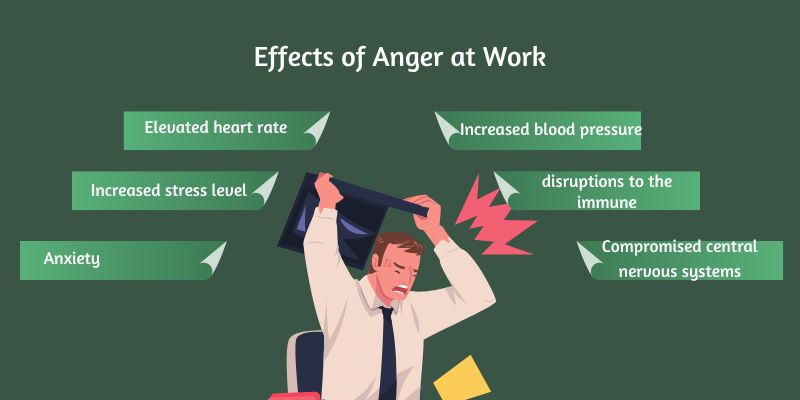
Anger in the workplace can have a significant impact on various aspects of one’s professional life.
Firstly, it can lead to increased stress levels, both mentally and physically.
When individuals experience anger at work, whether due to a specific incident or ongoing frustrations, their bodies often respond by releasing stress hormones such as cortisol and adrenaline. This heightened arousal can impair cognitive function and decision-making and contribute to tension and unease.
Prolonged exposure to workplace anger can contribute to anxiety, as individuals may constantly anticipate or dread encountering triggering situations. This chronic emotional distress can affect overall job satisfaction and performance, decreasing productivity and engagement.
Beyond mental health implications, anger at work can also manifest in physical health problems. Experiencing frequent anger or hostility in the workplace is associated with elevated heart rate, increased blood pressure, and disruptions to the immune and central nervous systems.
These physiological responses not only pose immediate health risks but can also contribute to long-term health issues such as cardiovascular disease and weakened immune function.
The effects of anger at work extend far beyond the immediate emotional response, permeating various aspects of one’s professional life and overall well-being. Recognizing and addressing these effects is essential for creating a healthier and more conducive work environment for all employees.
What Are the Common Causes of Anger at Work?
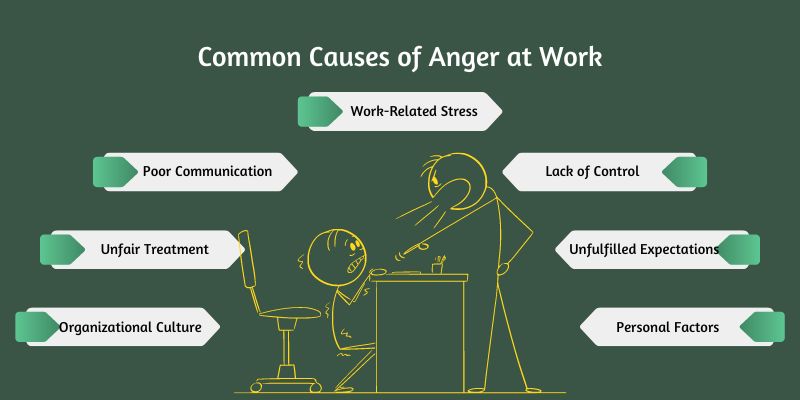
Exploring the complex arena of the modern workplace often involves encountering moments of frustration and anger.
Understanding the common triggers behind these emotions is essential for fostering a more harmonious and productive work environment.
- Work-Related Stress: Work-related stress is a primary driver of anger in the workplace. Excessive workloads, tight deadlines, and unrealistic expectations can overwhelm employees, leading to frustration and resentment. Additionally, lack of support or resources to cope with job demands can exacerbate stress levels, fueling anger towards work-related issues.
- Poor Communication: Ineffective communication within the workplace can fuel misunderstandings, misinterpretations, and conflicts, all of which can trigger anger. When communication channels break down, employees may feel ignored, undervalued, or misrepresented, leading to pent-up frustration and resentment towards colleagues or management.
- Lack of Control or Autonomy: Feeling micromanaged or deprived of autonomy in decision-making can evoke feelings of powerlessness and frustration. Employees who perceive a lack of control over their work processes or outcomes may experience heightened anger as they feel constrained or disregarded in their professional capacities.
- Unfair Treatment: Perceptions of unfair treatment, whether in terms of favoritism, discrimination, or unequal opportunities, can spark intense feelings of anger and resentment among employees. When individuals believe they are being treated unjustly or inevitably, it undermines their trust and morale, leading to heightened emotional reactions.
- Unfulfilled Expectations: When expectations regarding job roles, career advancement, or recognition are not met, employees may experience disappointment and anger. The misalignment between expectations and reality can fuel frustration and resentment, whether due to unfulfilled promises, lack of clarity in job responsibilities, or unrealistic expectations.
- Organizational Culture: The prevailing organizational culture, including norms, values, and leadership styles, can significantly influence workplace anger levels. Toxic cultures that tolerate or perpetuate hostility, competition, or lack of transparency can breed resentment and hatred among employees, leading to increased anger and dissatisfaction.
- Personal Factors: Personal factors such as unresolved conflicts, stressors outside of work, or mental health issues can also contribute to anger in the workplace. Individuals may bring personal baggage or emotional triggers into professional settings, affecting their ability to effectively manage emotions and interpersonal interactions.
By exploring these common causes of anger issues, we can gain valuable insights into effectively addressing and managing anger in professional settings, promoting healthier relationships, and enhancing workplace satisfaction.
How to Use Emotional Intelligence to Manage Workplace Anger?
Emotional intelligence (EI) plays an essential role in effectively managing workplace anger by enabling individuals to process and communicate emotions in a constructive manner.
EI refers to the ability to recognize, understand, and regulate one’s emotions, as well as empathize with the emotions of others.
Research has shown that individuals with high emotional intelligence are better equipped to navigate challenging situations and foster positive relationships in the workplace (Mayer, Caruso, & Salovey, 2016).
By developing EI skills, individuals can cultivate greater self-awareness and emotional resilience, allowing them to respond to anger triggers with composure and empathy.
Emotional intelligence empowers individuals to make informed decisions in the face of anger, enhancing self-control and emotional regulation abilities.
By understanding their emotional responses and considering the perspectives of others, emotionally intelligent individuals can defuse conflicts and find mutually beneficial solutions.
EI strengthens teamwork by facilitating effective communication and conflict resolution, fostering a collaborative work environment where differing viewpoints are respected and valued.
Additionally, EI aids in managing stress by promoting adaptive coping strategies and preventing the escalation of negative emotions into unproductive behavior (Brackett & Salovey, 2006).
Emotional intelligence guides verbal and non-verbal actions, including body language, in managing workplace anger.
Emotionally intelligent individuals are adept at expressing themselves assertively yet tactfully, using language that conveys respect and empathy.
Moreover, they are attuned to non-verbal cues such as facial expressions, gestures, and tone of voice, allowing them to gauge the emotional climate of interactions and adjust their communication accordingly.
By utilizing EI in verbal and non-verbal communication channels, individuals can foster constructive dialogue and cultivate a positive work environment conducive to managing anger effectively.
10 Ways to Deal with Anger at Work
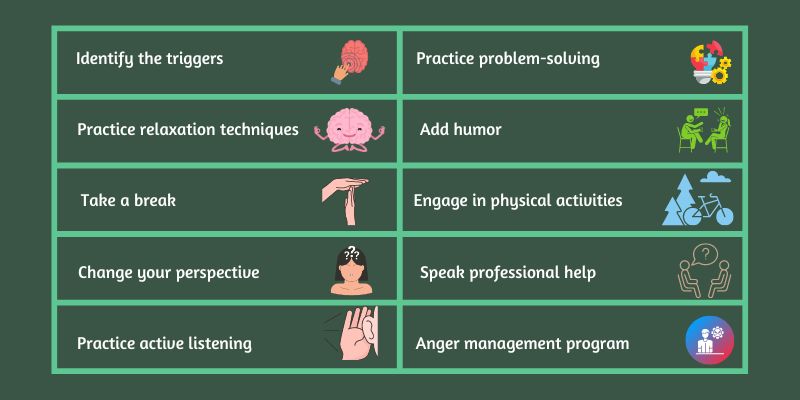
Effectively managing anger is essential for maintaining a positive and productive professional environment in the workplace.
By implementing strategies to address anger triggers, individuals can cultivate greater emotional resilience and enhance their overall job satisfaction. Here are several proactive approaches to dealing with anger at work:
Let’s explore each of these approaches in detail so you can incorporate them into your professional life to manage anger issues at the workplace.
1. Identify the Triggers
Understanding the triggers that evoke anger is the first step toward effective anger management.
By recognizing patterns and common triggers, individuals can anticipate and prepare for situations that might provoke anger.
This self-awareness enables individuals to develop strategies such as reframing perspectives, setting boundaries, or seeking support to manage or avoid triggering situations.
For example, suppose a particular colleague’s behavior consistently triggers frustration. In that case, individuals can practice empathy and perspective-taking to reframe their perceptions or establish clear boundaries to mitigate interactions that provoke anger.
Additionally, seeking support from trusted colleagues, mentors, or mental health professionals can provide valuable insights and coping mechanisms for managing anger triggers effectively.
By identifying and addressing triggers proactively, individuals can cultivate greater emotional resilience and maintain a positive work environment conducive to professional growth and success.
2. Take a Break
When confronted with anger at work, sometimes the most effective response is to step away from the source of frustration. Taking a break allows individuals to disengage from the triggering situation, cool down, and regain emotional balance.
Engaging in physical movements, such as taking a short walk around the office or stepping outside for fresh air, can further aid in dissipating pent-up tension and frustration.
By temporarily removing oneself from the source of anger, individuals can gain perspective and approach the situation with a calmer mindset, facilitating more constructive interactions and problem-solving.
3. Practice Relaxation Techniques
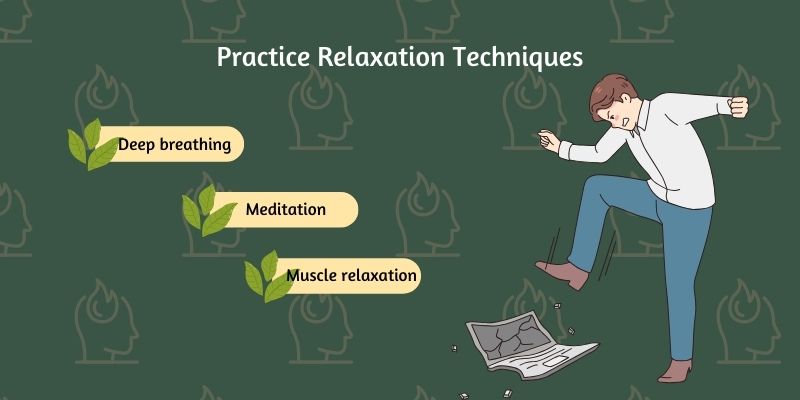
Incorporating relaxation techniques into one’s daily routine can effectively manage workplace anger.
Techniques such as deep breathing, meditation, and progressive muscle relaxation are proven methods for reducing muscle tension and promoting a sense of calm.
Deep breathing exercises help regulate the body’s stress response, while meditation fosters mindfulness and cultivates mental clarity.
Similarly, progressive muscle relaxation involves systematically tensing and releasing different muscle groups, promoting relaxation and reducing physical symptoms of stress.
By regularly practicing these relaxation techniques, individuals can regain control over their emotions and respond to workplace challenges with excellent composure and resilience.
4. Change Your Perspective
When faced with anger-provoking situations at work, one effective strategy is to change your perspective.
Reframing the situation more positively can help shift your mindset and alleviate anger or frustration. This involves extracting positives from decisions made by the organization or the scenarios at hand.
By focusing on the potential benefits or learning opportunities inherent in challenging situations, individuals can maintain a more optimistic outlook and cultivate resilience in the face of adversity.
Additionally, looking for humor in difficult situations can provide a welcome reprieve and help diffuse tension, fostering a more positive and constructive atmosphere in the workplace.
5. Practice Active Listening
Active listening is fundamental for managing workplace anger and fostering effective communication.
Individuals can demonstrate respect and empathy by focusing on the speaker and paying attention to verbal and non-verbal cues while gaining a deeper understanding of others’ perspectives.
Active listening involves hearing what is being said, acknowledging emotions, validating concerns, and seeking clarification when needed.
By creating a conducive environment for constructive communication and conflict resolution, active listening promotes mutual understanding and helps mitigate anger-provoking misunderstandings or conflicts in the workplace.
6. Practice Problem-Solving
When faced with anger-inducing situations in the workplace, practicing problem-solving techniques can be highly beneficial. This involves shifting your focus from dwelling on the source of frustration to actively seeking solutions.
By breaking down complex issues into smaller, manageable steps, individuals can approach problems systematically and methodically.
Brainstorming alternative approaches and considering the potential outcomes of each helps expand the range of possible solutions and enables individuals to make informed decisions.
Redirecting energy towards constructive actions reduces anger and promotes productivity and progress in resolving the underlying issues, fostering a more positive and proactive work environment.
7. Add Humor
Introducing humor into the workplace can be a powerful tool for diffusing tense situations and shifting perspectives.
Humor releases endorphins, the body’s natural feel-good chemicals, which can help reduce stress and promote a more positive atmosphere. However, it’s essential to use humor tactfully and ensure it doesn’t undermine the seriousness of the situation or offend others.
Managing anger with humor can be an effective strategy for diffusing tense situations and promoting a more positive atmosphere in the workplace. Here are some tips for incorporating humor into anger management:
- Use Light-hearted Jokes: Employ light-hearted jokes or playful banter to inject humor into conversations or interactions. Gentle humor can help alleviate tension and create a more relaxed environment, making it easier to address anger constructively.
- Find the Silver Lining: Encourage yourself to find humor in challenging situations by focusing on the absurd or unexpected aspects. By reframing difficulties more light-heartedly, you can shift your perspective and reduce the intensity of anger.
- Laugh at Yourself: Don’t take yourself too seriously. Embrace your quirks and mistakes with humor, and be willing to laugh at yourself. This self-deprecating humor can help you maintain humility and resilience in the face of frustration.
- Share Funny Stories: Share amusing anecdotes or funny stories with colleagues to lighten the mood and foster a sense of camaraderie. Shared laughter can strengthen bonds between team members and create a more supportive work environment.
- Use Comic Relief: Introduce comic relief during stressful meetings or discussions to break up tension. Incorporate humorous videos, memes, or cartoons related to the topic to provide a moment of fun and perspective.
- Stay Tactful: Be mindful of the context and audience when using humor to manage anger. Avoid sarcasm or jokes that may be interpreted as insensitive or offensive. Instead, opt for inclusive and light-hearted humor that resonates with everyone present.
- Know When to Stop: While humor can be a valuable tool for diffusing anger, it’s essential to recognize when it’s time to shift gears and address issues more directly. If humor isn’t effectively diffusing tension or requires a more serious approach, be prepared to pivot and refocus on finding constructive solutions.
By incorporating humor into your approach to managing anger, you can cultivate a more positive and resilient mindset, foster stronger relationships with colleagues, and navigate workplace challenges with grace and fun.
8. Engage in Physical Activities
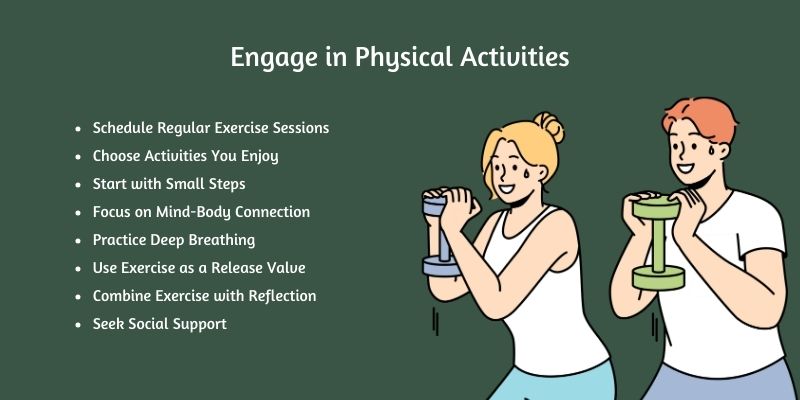
Regular physical activity, such as stretching, brisk walking, yoga, or strength training, can be a powerful tool for managing anger in the workplace.
Managing anger with physical activities involves incorporating movement and exercise into your routine to help release tension, reduce stress, and promote emotional well-being.
Here are some tips to effectively utilize physical activities for anger management:
- Schedule Regular Exercise Sessions: Set aside dedicated time for physical activities, whether a daily morning walk, a midday yoga session, or an evening workout at the gym. Consistency is key to reaping the benefits of exercise for anger management.
- Choose Activities You Enjoy: Select physical activities that you genuinely enjoy and look forward to, whether it’s dancing, swimming, hiking, or playing a sport; engaging in activities that please you can make exercise feel less like a chore and more like a rewarding experience.
- Start with Small Steps: If you’re new to exercise or have a busy schedule, start with small, manageable steps. Incorporate short walks during work breaks, take the stairs instead of the elevator, or try stretching exercises at your desk to gradually introduce physical activity into your daily routine.
- Focus on Mind-Body Connection: Choose activities that emphasize the mind-body connection, such as yoga, tai chi, or Pilates. These practices improve physical fitness and promote relaxation, mindfulness, and stress reduction, helping you manage anger more effectively.
- Practice Deep Breathing: Incorporate deep breathing exercises into your physical activities to enhance relaxation and emotional regulation. Focus on inhaling deeply through your nose, filling your lungs with air, and exhaling slowly through your mouth to release tension and calm your mind.
- Use Exercise as a Release Valve: When anger builds up, channel that energy into physical activity as a healthy outlet for release. Engage in high-intensity exercises like boxing, running, or cycling to channel adrenaline and release pent-up frustration constructively.
- Combine Exercise with Reflection: Pair physical activities with reflection or mindfulness practices to enhance their effectiveness for anger management. Use your exercise time to process emotions, gain perspective on anger triggers, and cultivate a more balanced mindset.
- Seek Social Support: Consider joining group exercise classes or sports teams to combine physical activity with social interaction. Sharing the exercise experience with others can provide a sense of camaraderie, support, and accountability, enhancing its therapeutic benefits for anger management.
By incorporating these tips into your approach to physical activities, you can harness the power of movement and exercise to effectively manage anger, promote emotional well-being, and cultivate a healthier relationship with stress and frustration.
By prioritizing physical health and incorporating exercise into your routine, you can maintain a healthy work-life balance and better cope with stressors in your professional environment.
9. Speak Professional Help
If anger at work becomes chronic or consistently affects your relationships, work performance, or quality of life, seeking professional help, such as therapy or counseling, is essential.
Professional support can provide valuable guidance and assistance in effectively managing and understanding your emotions.
Therapy or counseling offers a safe and confidential space to explore the underlying causes of your anger, whether they stem from workplace stressors, personal issues, or past experiences.
A trained therapist can help you identify triggers, patterns, and unhelpful thought patterns that contribute to your anger, allowing you to develop healthier coping strategies and responses.
Therapy can provide practical tools and techniques for managing anger in the workplace, such as relaxation exercises, communication skills, and conflict resolution strategies.
A therapist can also offer insights and perspectives on how to navigate difficult situations at work and build resilience in the face of adversity.
Seeking professional help for anger management can empower you to take control of your emotions, improve your overall well-being, and cultivate healthier relationships and work environments.
Don’t hesitate to reach out for support if you find that anger negatively impacts your life—it’s a proactive step towards positive change and personal growth.
10. Opt for a Workplace Anger Management Program
A workplace anger management class can be a proactive step toward effectively managing anger-related issues in professional settings.
Mastering Anger offers a structured course to equip participants with the skills and strategies to navigate anger-inducing situations and promote a more positive work environment.
A workplace-focused anger management program typically involves participants engaging in interactive sessions aimed at addressing different aspects of anger management.
These sessions may include identifying triggers, comprehending the physiological and psychological components of anger, and acquiring practical techniques for regulating emotions and responding constructively to challenging situations.
Participants also learn practical communication skills, conflict resolution strategies, and stress management techniques tailored to the demands of the workplace.
This program incorporates real-life scenarios and case studies relevant to professional settings, allowing participants to apply their newly acquired skills in practical contexts.
Participants gain hands-on experience navigating common workplace challenges and effectively managing interpersonal conflicts through exercises, group discussions, and individual coaching sessions.
Conclusion
Managing anger in the workplace is essential for fostering a positive and productive professional environment.
By understanding the common causes of workplace anger and implementing effective anger management strategies, individuals can navigate challenging situations with resilience and grace.
There are various avenues for addressing and defusing anger in the workplace, from identifying triggers and practicing emotional intelligence to engaging in physical activities and seeking professional help when needed.
Furthermore, incorporating humor, problem-solving techniques, and active listening skills can help individuals navigate conflicts and foster constructive communication with colleagues.
Additionally, enrolling in anger management programs tailored specifically for the workplace can provide valuable guidance and support in developing essential skills for managing anger effectively.
Ultimately, by prioritizing self-awareness, resilience, and interpersonal skills, individuals can cultivate a more harmonious work environment where collaboration thrives and professional relationships flourish.





Responses